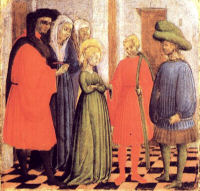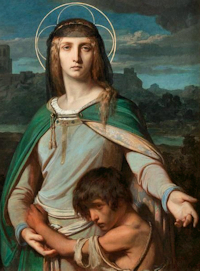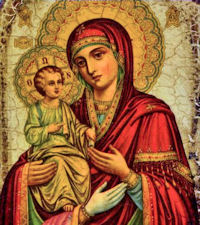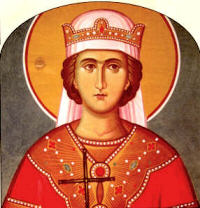Ordinary Time: August 27th
Memorial of St. Monica
Other Commemorations: Seven Joys of the Blessed Virgin Mary (Hist); Mary, Health of the Sick (Hist)
» Enjoy our Liturgical Seasons series of e-books!
St. Monica (333-387) was born in Tagaste, northern Africa and died in Ostia, near Rome. Monica was a Christian, but her husband Patricius was a pagan and a man of loose morals. Monica's virtues and prayers, however, converted him, and he was baptized a year before his death. When her son, Augustine, joined the Manichean sect and went astray in faith and morals, Monica's tears and prayers for her son were incessant. She followed him to Milan, where Augustine went to teach, and there continued to storm heaven with her prayers for her son. Finally, she had the joy of witnessing St. Ambrose baptize Augustine in 387. She died in Ostia, as she and her son gazed at the sea and discoursed about the joys of the blessed.
Today in the previous calendar (1962) is the feast of St. Joseph Calasanz, which is currently celebrated on August 26. St. Monica's feast is celebrated on May 4.
Historically today is the feast of the Seven Joys of the Blessed Virgin Mary.
St. Monica
 St. Monica is an example of those holy matrons of the ancient Church who proved very influential in their own quiet way. Through prayer and tears she gave the great Augustine to the Church of God, and thereby earned for herself a place of honor in the history of God's kingdom on earth.
St. Monica is an example of those holy matrons of the ancient Church who proved very influential in their own quiet way. Through prayer and tears she gave the great Augustine to the Church of God, and thereby earned for herself a place of honor in the history of God's kingdom on earth.
The Confessions of St. Augustine provide certain biographical details. Born of Christian parents about the year 331 at Tagaste in Africa, Monica was reared under the strict supervision of an elderly nurse who had likewise reared her father. In the course of time she was given in marriage to a pagan named Patricius. Besides other faults, he possessed a very irascible nature; it was in this school of suffering that Monica learned patience. It was her custom to wait until his anger had cooled; only then did she give a kindly remonstrance. Evil-minded servants had prejudiced her mother-in-law against her, but Monica mastered the situation by kindness and sympathy.
 Her marriage was blessed with three children: Navigius, Perpetua, who later became a nun, and Augustine, her problem child. According to the custom of the day, baptism was not administered to infants soon after birth. It was as an adolescent that Augustine became a catechumen, but possibly through a premonition of his future sinful life, Monica postponed his baptism even when her son desired it during a severe illness.
Her marriage was blessed with three children: Navigius, Perpetua, who later became a nun, and Augustine, her problem child. According to the custom of the day, baptism was not administered to infants soon after birth. It was as an adolescent that Augustine became a catechumen, but possibly through a premonition of his future sinful life, Monica postponed his baptism even when her son desired it during a severe illness.
When Augustine was nineteen years old, his father Patricius died; by patience and prayer Monica had obtained the conversion of her husband.
The youthful Augustine caused his mother untold worry by indulging in every type of sin and dissipation. As a last resort after all her tears and entreaties had proved fruitless, she forbade him entrance to her home; but after a vision she received him back again. In her sorrow a certain bishop consoled her: "Don't worry, it is impossible that a son of so many tears should be lost."
When Augustine was planning his journey to Rome, Monica wished to accompany him. He outwitted her, however, and had already embarked when she arrived at the docks. Later she followed him to Milan, ever growing in her attachment to God. St. Ambrose held her in high esteem, and congratulated Augustine on having such a mother. At Milan she prepared the way for her son's conversion. Finally the moment came when her tears of sorrow changed to tears of joy. Augustine was baptized. And her lifework was completed. She died in her fifty-sixth year, as she was returning to Africa. The description of her death is one of the most beautiful passages in her son's famous Confessions.
—Excerpted from The Church's Year of Grace, Pius Parsch
Patronage: Abuse victims; alcoholics; alcoholism; difficult marriages; disappointing children; homemakers; housewives; married women; mothers; victims of adultery; victims of unfaithfulness; victims of verbal abuse; widows; wives
Symbols and Representation: Monstrance; IHC on a tablet; veil or handkerchief; open book; girdle; staff; tears; cincture
Highlights and Things to Do:
- Learn more about St. Monica at:
- Read The Fruitful Tears of a Mother.
- For Children: St. Monica at Loyola Press.
- Read St. Monica Struggled to Surrender Her Son to God.
- Read So Many Tears: St. Monica.
- Where are the Relics of St. Monica? See the churches online: Sant'Agostino in Campo Marzioand Sant'Aurea a Ostia Antica.
- Pray the Novena to St. Monica and/or the Novena to St. Monica for Alcohol Addiction.
The Seven Joys of the Blessed Virgin Mary (Also known as The Franciscan Crown Rosary)
 The Franciscan Crown Rosary, properly known as "The Franciscan Crown of Our Lady's Joys" dates back to approximately the year 1422. According to tradition, as related by the famous Franciscan historian Father Luke Wadding, a very pious young man who had been admitted to the Franciscan Order in that year was saddened and had decided to return to the world and quit the cloister. Before his entry into the Order, it was his custom to adorn a statue of the Blessed Virgin with a wreath of fresh and beautiful flowers. Now, he was unable to continue his act of piety and devotion to the Blessed Virgin.
The Franciscan Crown Rosary, properly known as "The Franciscan Crown of Our Lady's Joys" dates back to approximately the year 1422. According to tradition, as related by the famous Franciscan historian Father Luke Wadding, a very pious young man who had been admitted to the Franciscan Order in that year was saddened and had decided to return to the world and quit the cloister. Before his entry into the Order, it was his custom to adorn a statue of the Blessed Virgin with a wreath of fresh and beautiful flowers. Now, he was unable to continue his act of piety and devotion to the Blessed Virgin.
Our Lady appeared to him and prevented him from taking such a step as he had planned. "Do not be sad and cast down, my son," she said, "because you are no longer permitted to place wreaths of flowers on my statue. I shall teach you to change this pious practice into one that will be far more pleasing to me and more meritorious to your soul. In place of the flowers that soon wither and cannot always be found, you can weave for me a crown from the flowers of your prayers that will always remain fresh and can always be had." When Our Lady had disappeared, the overjoyed Novice at once began to recite the prayers in honor of her Seven Joys, as she had directed. While he was deeply engrossed in this devotion, the Novice Master happened to pass by and saw an angel weaving a marvelous wreath of roses. After every tenth rose, he inserted a golden lily. When the wreath was finished, the angel placed it on the head of the praying Novice. The Novice Master demanded the Novice tell him the meaning of this vision. The joyful Novice complied. The good priest was so impressed that he immediately made it known to his brethren. Thus, the practice of reciting the Franciscan Crown of Our Lady's Joys soon spread as a favorite devotion of the Friars.
The Joys of Mary remembered in the devotion are these:
- The Annunciation of the Angel to Mary
- The Visitation of Mary to Elizabeth
- The Nativity of Our Lord
- The Adoration of the Magi
- The Finding of Jesus in the Temple
- The Resurrection of Our Lord
- and The Crowning of Our Lady, Mary, in Heaven as Queen
—Excerpted from The Franciscan Order of the Divine Compassion
Highlights and Things to Do:
- See also Seven Joys of Mary at Roman Catholic Saints.
- Read Feast Day of the Seven Joys of Mary for more information.
- See Seven Joys at All About Mary at University of Dayton. (Formerly known as the Mary Page.)






